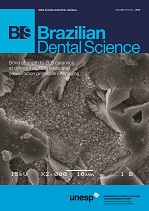Retentiveness comparison of individual clasps made from polyamide, acetate resin and cobalt-chrome for removable partial dentures
DOI:
https://doi.org/10.14295/bds.2019.v22i4.1802Abstract
Objective: This study aimed to evaluate and compare the retention force of individual clasps made from polyamide, acetate resin and cobalt-chrome for removable partial dentures. Material and methods: Three groups of clasps were fabricated: Cr-Co - 10 conventional chrome-cobalt metal clasps; Ac - 10 clasps with reciprocal arms and occlusal rests in chrome-cobalt and retentive arms in acetate resin; and Poly - 10 clasps with reciprocal arms and occlusal rests in chrome-cobalt and retentive arms in polyamide resin. Through the tensile test, in a universal testing machine, the initial retention force of the specimens was obtained and then clasps were cycled 7200 times, immersed in artificial saliva (60 months of simulated clinical use). After cycling, tensile test was performed. Results: All groups presented a retention decrease after the cycling. Ac presented a large reduction in retentive force (61.43%), followed by Cr-Co (26.5%) and Poly (12.09%). Conclusions: Aesthetic clasps of polyamide can be used in clinical cases where the anterior supporting teeth will not be essential for good retention of the removable partial denture because this clasp showed to be more resistant than the acetate resin.
Downloads
Downloads
Published
How to Cite
Issue
Section
License
Brazilian Dental Science uses the Creative Commons (CC-BY 4.0) license, thus preserving the integrity of articles in an open access environment. The journal allows the author to retain publishing rights without restrictions.
=================




























